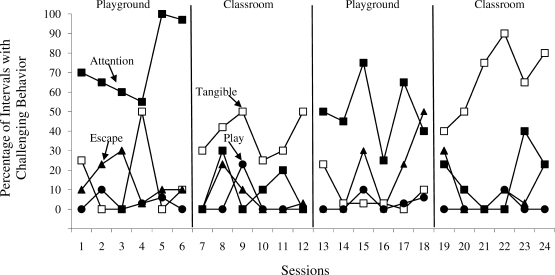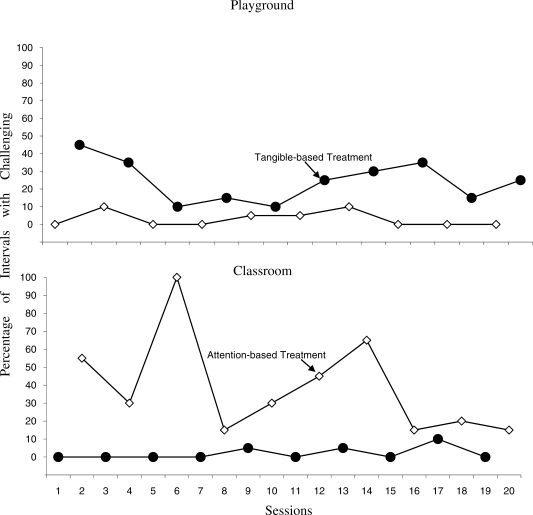Abstract
Functional analyses that were conducted in two settings (playground and classroom) indicated that problem behavior was sensitive to adult attention on the playground and tangible items in the classroom. Attention- and tangible-based interventions were designed based on the results from each of the assessment environments and were compared. The attention-based intervention was more effective on the playground, and the tangible-based intervention was more effective in the classroom. Findings are discussed in regards to the generality of functional analysis results across environments.
Keywords: assessment, autism, criterion settings, functional analysis, intervention design
Successful functional analyses have been conducted in many settings, such as hospitals, outpatient clinics, classrooms, and children's homes (Hanley, Iwata, & McCord, 2003). It is common for the results of a functional analysis conducted in one environment to be used in the design of an intervention implemented in another environment. When this is done, it is assumed that the variables that influence behavior in one environment also influence behavior in the same way in another environment.
Lang et al. (2008) tested this assumption by comparing the results of functional analyses conducted in a two settings (a therapy room and a classroom) with 2 children with autism. The results were the same across environments for one child; however, problem behavior served different functions in the two settings for the other child. For this child, problem behavior appeared to be negatively reinforced by escape from task demands in the therapy room but was positively reinforced by attention when assessed in the classroom.
In the current study, we replicated the methods of Lang et al. (2008) by conducting identical functional analyses across two settings (classroom and playground) for a student with problem behavior. These identical functional analyses suggested that the problem behavior was multiply maintained; it was more sensitive to attention on the playground and more sensitive to tangible items in the classroom. The effectiveness of two interventions (one attention based and one tangible based) was then evaluated in both settings.
METHOD
Participant, Setting, and Measurement
Carl, a 4-year-old boy with autism spectrum disorder, participated in this study. His problem behavior included screaming (vocalizations of inappropriately loud volume) and aggression towards adults (hitting, kicking, and pinching). Screaming and aggression occurred simultaneously (i.e., he would begin to scream while attempting to hit). Data on target behaviors were collected using a 10-s partial-interval procedure. These data were converted to a percentage by dividing the number of 10-s intervals in which the behavior occurred by the number of 10-s intervals in the session. Interobserver agreement data were collected during both the functional analyses and the intervention analyses, and agreement scores were determined using the method described by Thompson and Iwata (2007). Interobserver agreement was calculated for 54% of sessions, with mean agreement scores above 90%.
Sessions were conducted in a private school for children with developmental delays. Separate functional analyses with identical procedures, materials, and task demands were conducted in Carl's typical classroom and playground. The classroom (4 m by 9 m) contained tables, chairs, and other typical classroom items (i.e., toys, instructional materials). Three to six other children with developmental delays were also present in the classroom. Children worked in groups of two and three or individually with a teacher. Two or three teachers were in the classroom at all times.
The outdoor playground was approximately 20 m by 25 m and contained playground equipment (e.g., slides, swings, wooden fort, jungle gym). Three to 12 other children and one to five teachers were present on the playground. The first author and one or two data collectors were also present during classroom and playground sessions.
Functional Analyses
Problem behavior was assessed during 5-min sessions across four conditions: attention, escape, tangible, and play (control). The first author implemented the functional analyses for all sessions in the classroom and on the playground. In the classroom, the functional analyses were conducted at the table where Carl normally worked. Sessions were conducted at a picnic table on the playground, because he spent much of his time playing on the picnic table during recess. Toys used during the functional analyses (e.g., small robot) were identified by teachers and parents.
During the attention condition, the therapist sat next to Carl and assumed the appearance of reading a notebook; Carl was given free access to toys and instructed to play while the therapist worked, and the therapist delivered 5 s of attention following the occurrence of problem behavior. Task demands issued during the escape condition were based on Carl's individualized education plan and were the same as those issued during regular classroom instruction. Tasks included placing different plastic shapes into corresponding shape slots and manually signing names of common objects presented on picture cards. The therapist used three-step prompting to issue demands and terminated the demands and removed the instructional materials for 5 s following problem behavior. In the tangible condition, the therapist placed toys in sight but out of reach and delivered the toys for 10 s following the occurrence of problem behavior. When delivering the toys, the therapist avoided making eye contact and provided no verbal response or physical contact. During the play condition, the therapist did not present educational tasks or materials, and Carl had unrestricted access to the toys. The therapist maintained close proximity to Carl and provided verbal praise and physical contact at least once every 30 s. The therapist ignored all problem behavior.
Conditions were alternated according to a multielement design for each functional analysis, and the influence of the analysis setting (i.e., classroom vs. playground) was examined in an ABAB design in which A was the functional analysis conducted in the playground and B was the functional analysis conducted in the classroom. The same protocol, condition sequence, and number of functional analysis sessions were repeated across each phase of the reversal design.
Intervention Evaluations
Because noncontingent reinforcement (NCR; Tucker, Sigafoos, & Bushell, 1998) has been shown to be effective for problem behavior maintained by access to tangible items (Hagopian, Crockett, van Stone, DeLeon, & Bowman, 2000) and attention (Hagopian, Fisher, & Legacy, 1994), two NCR interventions were evaluated in a multielement design in the classroom and playground. Treatment sessions lasted 30 min.
Because the functional analysis data from the playground suggested that problem behavior was consistently sensitive to adult attention as reinforcement, an attention-based intervention was designed for the playground. This intervention consisted of the teacher providing Carl with verbal praise, pats on the back or high fives, or telling him, “I am watching you play” every 30 s. The teacher ignored problem behavior, and tangible items were not provided following problem behavior. A second reinforcement-based intervention based on a tangible function of problem behavior (described below) was also applied in the playground setting.
Because the functional analysis data from the classroom suggested that problem behavior was consistently sensitive to toys as reinforcement, a tangible-based intervention (noncontingent access to a toy) was designed for the classroom. To minimize the number of toys on Carl's desk, he was allowed to select one toy from the same group of toys used during the functional analysis. When problem behavior occurred, the teacher, without making eye contact, speaking, or making physical contact, set the box of toys that were not chosen at the beginning of the session next to Carl and moved the chosen toy closer. It is important to note that this action may have functioned as reinforcement; therefore, an extinction component may not have been in place for the tangible intervention. The attention-based intervention, described above, was also applied in the classroom.
RESULTS AND DISCUSSION
The results of the initial playground functional analysis indicated that problem behavior was maintained by both adult attention and access to tangible items (see Figure 1). However, problem behavior appeared to be much more sensitive to adult attention as reinforcement on the playground. This general pattern was replicated in the second functional analysis conducted on the playground (Sessions 13 through 18). The results of the initial functional analysis in the classroom indicated that problem behavior was again multiply maintained by adult attention and tangible items, but in this setting it appeared to be more sensitive to toys as reinforcement. These results were replicated in the second analysis in the classroom.
Figure 1.
Results of functional analyses across the playground and classroom settings.
These results suggest that although problem behavior may occur at similarly high rates in two settings, the controlling variables may differ across the settings (see also Lang et al., 2008). Ringdahl and Sellers (2000) observed a similar relation when different therapists (caregivers vs. clinical staff) implemented functional analyses, in that problem behavior was more sensitive to functional reinforcers when delivered by caregivers.
Figure 2.
Results of the attention-based and the tangible-based interventions conducted on the playground (top) and in the classroom (bottom).
To evaluate the clinical relevance of such findings, the current study compared the relative effectiveness of two different NCR interventions that were based on the different functional analysis results (see Figure 2). On the playground, when attention was potentiated, the attention-based intervention resulted in a more substantial reduction in problem behavior. However, in the classroom, when preferred tangible items were potentiated, the tangible-based intervention resulted in a more substantial reduction.
These results appear to validate the results of the functional analyses. Perhaps more important, the comparison of the interventions within each environment suggests that a functional analysis that is not conducted in a criterion setting (i.e., the setting in which the intervention will be implemented) may lead to the design of an ineffective intervention.
Future research should focus on the generality of this relation between the assessment setting and treatment outcomes. Even though the question of generality is important, it is a question that would require a large number of participants to provide a satisfactory answer. If discrepant results are common, the practice of conducting functional analyses in noncriterion settings will require reconsideration. As an alternative, it may be best to conduct functional analyses in criterion settings initially whenever possible and after treatment failures that occur following functional analyses in noncriterion settings.
Acknowledgments
We thank Angel Flier, Amanda Rogers, Tina Fragale, and Carl and his family for their help during this study.
REFERENCES
- Hagopian L.P, Crockett J.L, van Stone M, DeLeon I.G, Bowman L.G. Effects of noncontingent reinforcement on problem behavior and stimulus engagement: The role of satiation, extinction, and alternative reinforcement. Journal of Applied Behavior Analysis. 2000;33:433–449. doi: 10.1901/jaba.2000.33-433. [DOI] [PMC free article] [PubMed] [Google Scholar]
- Hagopian L.P, Fisher W.W, Legacy S.M. Schedule effects of noncontingent reinforcement on attention-maintained destructive behavior in identical quadruplets. Journal of Applied Behavior Analysis. 1994;27:317–325. doi: 10.1901/jaba.1994.27-317. [DOI] [PMC free article] [PubMed] [Google Scholar]
- Hanley G.P, Iwata B.A, McCord B.E. Functional analysis of problem behavior: A review. Journal of Applied Behavior Analysis. 2003;36:147–185. doi: 10.1901/jaba.2003.36-147. [DOI] [PMC free article] [PubMed] [Google Scholar]
- Lang R, O'Reilly M, Machalicek W, Lancioni G, Rispoli M, Chan J.M. A preliminary comparison of functional analysis results when conducted in contrived versus natural settings. Journal of Applied Behavior Analysis. 2008;41:441–445. doi: 10.1901/jaba.2008.41-441. [DOI] [PMC free article] [PubMed] [Google Scholar]
- Ringdahl J.E, Sellers J.A. The effects of different adults as therapists during functional analyses. Journal of Applied Behavior Analysis. 2000;33:247–250. doi: 10.1901/jaba.2000.33-247. [DOI] [PMC free article] [PubMed] [Google Scholar]
- Thompson R.H, Iwata B.A. A comparison of outcomes from descriptive and functional analyses of problem behavior. Journal of Applied Behavior Analysis. 2007;40:333–338. doi: 10.1901/jaba.2007.56-06. [DOI] [PMC free article] [PubMed] [Google Scholar]
- Tucker M, Sigafoos J, Bushell H. Use of noncontingent reinforcement in the treatment of problem behavior: A review and clinical guide. Behavior Modification. 1998;22:529–547. doi: 10.1177/01454455980224005. [DOI] [PubMed] [Google Scholar]




